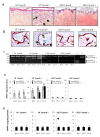Tspan8 Drives Melanoma Dermal Invasion by Promoting ProMMP-9 Activation and Basement Membrane Proteolysis in a Keratinocyte-Dependent Manner
- PMID: 32455575
- PMCID: PMC7281247
- DOI: 10.3390/cancers12051297
Tspan8 Drives Melanoma Dermal Invasion by Promoting ProMMP-9 Activation and Basement Membrane Proteolysis in a Keratinocyte-Dependent Manner
Abstract
Melanoma is the most aggressive skin cancer with an extremely challenging therapy. The dermal-epidermal junction (DEJ) degradation and subsequent dermal invasion are the earliest steps of melanoma dissemination, but the mechanisms remain elusive. We previously identified Tspan8 as a key actor in melanoma invasiveness. Here, we investigated Tspan8 mechanisms of action during dermal invasion, using a validated skin-reconstruct-model that recapitulates melanoma dermal penetration through an authentic DEJ. We demonstrate that Tspan8 is sufficient to induce melanoma cells' translocation to the dermis. Mechanistically, Tspan8+ melanoma cells cooperate with surrounding keratinocytes within the epidermis to promote keratinocyte-originated proMMP-9 activation process, collagen IV degradation and dermal colonization. This concurs with elevated active MMP-3 and low TIMP-1 levels, known to promote MMP-9 activity. Finally, a specific Tspan8-antibody reduces proMMP-9 activation and dermal invasion. Overall, our results provide new insights into the role of keratinocytes in melanoma dermal colonization through a cooperative mechanism never reported before, and establish for the first time the pro-invasive role of a tetraspanin family member in a cell non-autonomous manner. This work also displays solid arguments for the use of Tspan8-blocking antibodies to impede early melanoma spreading and therefore metastasis.
Keywords: MMP-9; Tetraspanin 8; dermal-epidermal junction; dermis; melanoma invasion; melanoma-keratinocytes crosstalk; tumor microenvironment.
Conflict of interest statement
The authors declare no conflict of interest.
Figures







References
-
- Gershenwald J.E., Scolyer R.A., Hess K.R., Sondak V.K., Long G.V., Ross M.I., Lazar A.J., Faries M.B., Kirkwood J.M., McArthur G.A., et al. Melanoma staging: Evidence-based changes in the American Joint Committee on Cancer eighth edition cancer staging manual. CA Cancer J. Clin. 2017;67:472–492. doi: 10.3322/caac.21409. - DOI - PMC - PubMed
-
- Werner-Klein M., Scheitler S., Hoffmann M., Hodak I., Dietz K., Lehnert P., Veronika N., Bernhard P., Steffi T., Christian W., et al. Genetic alterations driving metastatic colony formation are acquired outside of the primary tumour in melanoma. Nat. Commun. 2018;9:595–599. doi: 10.1038/s41467-017-02674-y. - DOI - PMC - PubMed
Grants and funding
LinkOut - more resources
Full Text Sources
Research Materials
Miscellaneous

